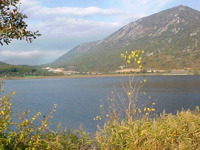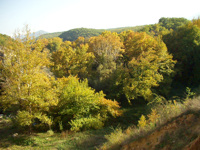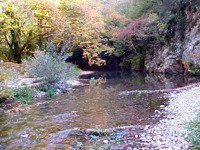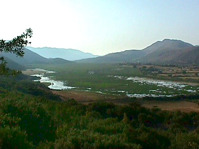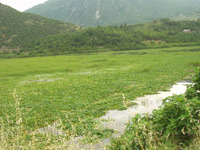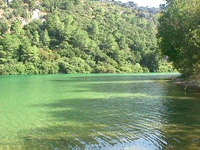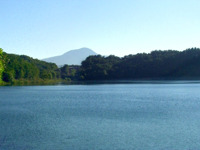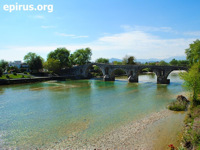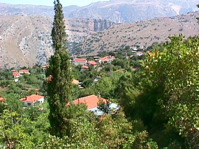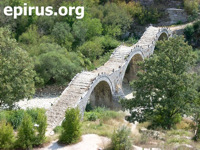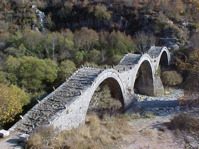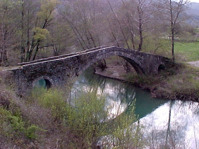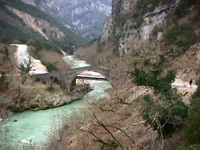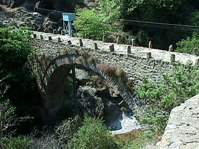epirus net
Αξιοθέατα, δραστηριότητες, ξενοδοχεία,
ξενώνες & ενοικιαζόμενα δωμάτια στην Ήπειρο.
ξενώνες & ενοικιαζόμενα δωμάτια στην Ήπειρο.
Byzantine Monastery of Parigoritissa
The Byzantine Monastery of Parigoritissa is in the centre of the city of Arta. It is about the most important byzanitne monument of Arta, a masterpiece of byzantine art built in basilica archtitecture. It was built between the years 1283 – 1296 and opened as a monastery for the women. The monastery was built on the ruins of an ancient temple by Nikoforos I Komninos the Duke and his wife Anna Palaiologina Kantakouzini.
The architecture of the temple, the wallpaintings, its sculptures, the magnificent dome and generally the inside and outside decoration, are an excellent sample of the age of the Despotate of Epirus. This splendid church is dedicated to the Annunciation. For the history of the church there are many details in various book editions and papers.
From the old monastery for women, have been saved: The church, the Altar, 16 cells and the Dining Hall (dining room) which has been reconstructed and houses findings from the ancient Amvrakia.
The monastery has been characterised preservable and is open to the public as a museum. It belong to the Ephorate VIII of Antiquities.
Museum phone number: +30 26810.28692
Monastery of Virgin Mary of Vella in Vourgareli (Red Church)
The Red Church is at the location of Palaiochori, close to Drosopigi (Vourgareli) of the prefecture of Arta, at a distance of 56 km. from the city of Arta. Its building dates back in the end of the 13th century, when Nikiforos I was the Despot of Arta (there is a sign about it inside the Church). The Red Church λis said that took its name from the colour of the bricks that the outside walls are built. It is also called “Basilomonastery” but also Virgin Mary of Vella, because close to it there was probably an ancient town named Vella or by the fact that it became later a glebe of the Monastery of Vella of Ioannina.
It is an exceptional sample of Church archtitecture of Byzantine art, dedicated to the Birth of Virgin Mary and is maintained in an excellent condition until nowadays. It is a double columned church wirh a cross-shpaed roof and a plastering iconostasis. The outside decoration is similar to this of the church of St. Vasileios which is in the city of Arta. It is lightened by big arched windows.
A sign mentions that the wallpaintings of the main church were painted in 1295 and 1296. Νowadays are saved only a few wallpaintings. In the main part of the church they are maintained in better condition, and there is also saved a very interesting wallpainting which shows Virgin Mary holding Christ surrounded by two couples of the founders of the church, of the couple of Theodoros Tzimiskis and his wife Maria who donated the wallpainting of the church and the couple of Ioannis Tzimiskis and his wife Anna. These portraits especially are considered to be the most ancient ones in Balkans. The byzantine door of the main part of the church is wooden and is still saved.
Monastery of St. George of Riachovo
At the location of Dobritsi of Riachovo, which belongs to the region of Pogoni of the prefecture of Ioannina, is the Monastery of St. George of Riachovo, in a magnificent natural environment.
The monastery was founded and started its building on March in 1998 and was complete on December in 2004, under the supervision and the care of the priest of Riachovo, I. Besios.
The monastery of Riachovo belongs to the Metropolis of Ioannina and in a little time after its opening has shown a significant effort of work.
In the monastery besides the church, there are also available spaces for many kinds of activities, such as: an Amphitheatre for cultural events, entertainment places, basket court, playground, etc.
In the monastery there is also a guesthouse for the hosting of the abandoned elderly persons of the region and it can host 20 persons totally. The guesthouse has 8 double rooms and one triple room.
The region is very interesting for every visitor, as you can enjoy the nature with the beautiful forests of the region, the water from the springs of the region, etc. The region is especially appropriate for school trips.
For more information, Tel.: +30 26510.61315 & +30 6946 148308
Monastery of Paganioi
It is close to the village Kallithea in a dominant position, into a wholegreen region. Its founder was the monk Ioakeim (1652) as it is written on the gate of the church. It is said that the monastery was a glebe of the big cave of Kalavryta. It was a wealthy monastery and a centre during the National Wars. Its history is not famous because its heirlooms and the records were hiiden in 1944 (during the Second World War) by the priest Chis and after were lost.
The architcture of the temple was initially basilica with a dome (that collapsed). The wallpaintings are from different periods, 17th and 19th century, and of excellent technique. The older ones are those of the holy gate (16th – 17th century). The best of them is the icon of the Dormition of Virgin Mary.
The holy gate seems that was preserved by the older existing church during the renovation in 1652. Behind the temple is the cemetery of the bishops Iosif and Amvrosios. It was a monastery for men that was dstroyed in 1944, and it was abandoned until 1962, the year of its renovation. Moreover, recently it was renovated once again. The monastery celebrates on August 15th.
Monastery of St. Nicolas of Flianthropinoi
The monastery of St. Nicolas of Filanthropinoi is at the island of Pamvotis lake. Next to the entrance you can see well-preserved cells and ruins of other buildings. The church is of on space with an arched roof.
It was built by Michael Filanthropinos in the year 1272. It is wallpainted with exceptional mural of 1542 painted with care by Ioasaf Filanthropinos.
In the shape of “Π” around the walls of church there are wallpaintings of 1560. It is distinguished for its value the wallpainting of the 7 wisemen of Greece, which is rare for the orthodox church (during the period when the monastery was open, the ancient greek language was taught in it).
It is also called monastery of Spanos because there taught the Master Spanos. During the period of the despotate of Epirus and after of Ali Passia, it was the most important Religious and Cultural centre.
Monastery of St. Paraskevi of Monodendri
In the famous for its beauty village Monodendri of Zagori, at the cliff of the gorge of Vikos, there is the monastery of St. Paraskevi, which is one of the most ancient monasteries of Epirus.
A beautiful stoned path built in 1412 by Michael, Voevodas of Thereanos, leads us to the entrance of the monastery. It is about a real monastery – fortress: Arched gate, stone buildings, well-built cells, well, trap door, etc. where leads the artistic buliding with stone.
The small church has some old wallpaintings and is also a church of one space with a wooden painted iconostasis. On the left side are painted the founder of the Monastery Voevodas, his wife and his daughter Paraskevi, who acoording to the tradition, passed her whole life in the monastery.
The monastery with its caves by side was a safe shelter for the habitants of the region during the period of revolution against the Turks, Its wild beauty of the around space and the monastery, along with the magnificent Vikos gorge at the region of Monodendri, attracts a lot of tourists every year.
Monastery of Virgin Mary of Kipina
The Monastery of Kipina is close to the village Christoi of Pramanta . According to its history, it owes its name to the gardens close to the monastery that the monks cultivated. According to Serafeim Byzantious the monastery was built in 1212 by someone archbishop named Gregory and is dedicated to the Dormition of Virgin Mary.
It is one the most impressive monasteries of Epirus because it is hanged on a high vertical rock. The paved road reaches to the base of the rock and from that point there is a path on the rock and a wooden bridge that lead to the monastery. During the revolution against the Turks the wooden bridge could be moved. The monks moved it with a lever so as to be protected by invasions.
The small church of the monastery has a lot of wallpaintings probably of the 17th century. The church has the bulk of the rock as roof which creates a perfect dome. Unfortunately many robers took from the monastery many of its holy heirlooms.
At the entrance of the chuch on the left side there is a deep dark cave. During the period of the revolution against the Turks the habitants of the nearby villages were hidden there fro thei safety. The length of the cave is 240 m. and was excavated in 1956 by the speleologist Anna Petrochilou, but it is not approachable.
Monastery of Molyvdoskepasto
Close to the village Molyvdoskepasto of the region of Konitsa, at the borders with Albania and at a distance of 72 km. from Ioannina, there is the walled monastery which is dedicated to the Dormition of Virgin Mary and celebrates on August 15th.
It owes its name, to its roof which in the past had stones of lead. Nowadays the roof of the monastery is made of grey stones.
The hall of the monastery is wallpainted. The woodcarving door is a real masterpiece. There are beautiful wallpaintings, woodcarving pilgrimage hall, arched windows with ceramic decoration. The woodcarving iconostasis is of the 16th century and of excellent technique.
The church has a cross-shaped roof, a high dome and its floor is stoned. The monastery was probably built by the Byzantine Emperor, Constantine Pogonatos.
The sign of the church mentions the year 1521. ΣIn the yard of the church there is the simple grave of Sevastianos, the Despot of Konitsa – Dryinouples.
Monastery of St. Dimitrios in Zalogo
The monastery of St. Dimitrios is under the famous rock of Zalogo with the imposing monument of the dancing women of Souli. It was founded in the middle of the 18th century by the abbot of the Monastery of St. Taxiarches, Dionysious, and from a glebe was turned into a monastery. It is a historical preservable monument.
It was painted by Chistodoulos and Ioannis, wallpainters from Koritiani, in 1816. The monastery λwas conquered and destroyed several times by the Turks, as well as an earthquake destroyed the monastery once again in 1924, but it was renovated.
It was always a monastery for men and not for women. It had a large property and did a lot of charities and donated many works. It had also a lot of glebes.
Nowadays is saved the church (basilica of one space with dome) of the monastery with beautiful wallpaintings inside and outside it, as well as in the cells of the monastery.
Monastery of St. Panteleimon of Ioannina
It is in the island of Pamvotis lake and was founded on the 15th century. It is a historical preservable monument. Inside the monastery was written the end of the life of Ali Passia of Ioannina, who was sieged by the forces of Choursit Passa and under the orders of Sultan, who characterised him as a rebel. So Ali Passia hid here and in the end he was beheaded in 1822.
He was in the middle cell when he was shot αfrom the basement and the bullet injured him in his belly. It is also obvious the point where the bullet passed through the floor. Lady Vasiliki who was with him, was sent away and lived until her death at the village Aitoliko of Aitoloakarnania. Her grave is still saved behind the chuch of St. Taxiarches in Aitoliko.
From the monastery are still saved the temple, the renovated building of the library and three cells which have been converted into a museum of greek history before the revolution (in the museum there are a lot of weavings, jewels, vessels, etc.).
The monastery was burnt in 1822 but it was rebuilt in 1925. Its temple is basilica of three spaces and a wooden roof. It has also a magnificent wooden iconostasis and a hall outside it. The main church is separated with columns in three spaces.
In the outside space there are maginificent wallpaintings of the 15th century. There are also many significant portable icons of the 15th and the 19th century.
Monastery of St. George in Vourgareli
The Monastery of St. George is in a forest region, very close to the village Drosopigi (Vourgareli) of the prefecture of Arta. It is a monastery with walls around it and according to a sing its main church was built in 1690. The temple and the cells (the cells were built later) are saved in an excellent condition.
The church is of one space, basilica, cross-shaped with a big octagonal dome and outside the church stands on big butresses. The main church has wallpaintings from 1714 by painters from Kalarrytes, according to a relevant sign (there is also a version that says that the monastery was built in 1714, the same year of its wallpainting).
The iconostasis is woodcarving and was painted in the beggining of the 18th century. The portable icons of the church are also from the 18th century, a piece of art of Epirus. The most significant heirloom of the monastery is a silver shrine of the 1859, carved by a silversmith from Kalarrytes.
It is a historical monastery and it was a revolutionary and cultural centre during the revolution against the Turks. Here the abbot Christopher in front of the warriors (G. Karaiskakis, Gogos Mpakolas, Koutelisas, Iskos, Raggos, Koutsonikas) and other rebels, raised the flag of the revolution against the Turks.
Monastery of St. Pelagia
In the village Kastrosykia of Preveza, close to the central road, there a sign leading us to the monastery of St. Pelagia. It is a well-preserved monastery, as the monks live there until today. It has old and new cells, and there is the church in the centre of it. It is one of the monasteries that financed in the past the schools of the region.
The monastery was renovated in 1613 and in 1795. Various Roman ruins are distinguished. From the ruins were stolen many reliefs and placed in the Church, just like the two lions in the entrance. The Church is unplastered, built by flint with three spaces, basilica with dome. The High Altar is based on an old stand and on the columns of the dome are distinguished korinthian caps and an ionic base.
Byzantine church of St. Vasileios in the city of Arta
The Byzantine church of St. Vasileios Βis located close to the church of St. Theodora, inside the city of Arta, at the district “Tourkopazaro”. It was built in the beggining of the 15th century, but because of its techique some claim that was probably built during the 13th century. Close to the main church there are also the churches of St. Gregory and Ioannis Chrysostomos, that commumicate inside with the central church.
Except for the wallpaintings σinside the Church significant is also the portable icon of Virgin Mary with Christ on the iconostasis, of Cretan art. It is about a church whose ceramic decoration, the glass tiles and its bivalve windows make it a real piece of work. Impressive are also the icons of glazed clay that show the Crucifixion and Three Ierarchs that there are on the top of the east side of the roof.
The wallpaintings of the church date back to the 17th century. Its roof was burnt in 1821. The only thing we know from its history is that in its yard was located the Manolakis school from 1662 to 1821.
Metropolitan church of St. Athanasios
The Metropolitan Church of St. Athanasios βis close to the Metropolis of Ioannina and at Metropolis street in the city of Ioannina. We know that is was built before 1611 and was saved by the revolution of Dionysius the Philosopher. It was burnt in 1820 on 25th August.
The today’s church was inaugurated in 1833 and it is a piece of work of the builders Liolis and Dosis from the village Vourbiani of Konitsa. The building is made of balck and white stone.
The architecture of the church is basilica, of three spaces with domes. Charecteristic of the church is that its floor is at a lower level than the ground.
Its iconostasis of walnut tree, the dome and its pulpit have carved pictures of animals and plants. The traveller Strangford mentions that the church is one of the most important sights in Ioannina.
The wallpaintings of the church date back to 1835. The dome was built in 1816, while the belltower was built in 1905 by the architector Pericles Melirrytos and is made of carrved stone. The arched main entrance is also beautiful.
Monastery of Voutsa
The Monastery of Voutsa is close the village Greveniti (44 km. from Ioannina) in Eastern Zagori. There is a path of 5 km. in the village leading to the monastery. It is dedicated to Virgin Mary and celebrates on 8th September.
Founder of the Monastery of Voutsa seeme to be the Byzantine Emperos Constantine IV Pogonatos.
The Monastery was totally destroyed by the Turks during the 15th century and was built again in 1680 (according to a sign). The Germans burnt it in 1943 during the Second World War and the only was saved was the church. In 1950 all of its spaces were rebuilt.
The inner side of the church, with arches and croos-domed, is wallpainted by the priest Athanasios and the monks Antonios and Nikodimos (1680 – 1769).
Monastery of St. Nicolas of Metsovo
It is the monastery of St. Nicolas which loved and took care of it the nobleman Evagelos Averof – Tositsa. It located at the stream under Metsovo (at the road to Anilio).
It is unknown when the monastery was built. The year 1700 on a cornerstone refers probably at its renovation. It was a wealthy monastery (it was found a wooden tub that holded about 12.000 litres of wine).
It is about a big complex of buildings with kitchens, cells, warehouses, basements and it also has a hall where the writer Evagelos Averof wrote many of his books.
The belltower is wooden, the church is domed of one space with beautiful wallpaintings that were revealed. There are icons that date back in 1698 and 1703.
Its iconostasis is woodcarving (from spieces of the olde one). The women seats have jalousies windows. It is one of the most important monasteries of the region and is well-preserved.
Monastery of Avel in Vissani
The monastery of Avel is close to the village Vissani in a beautiful location. It probably took its name by a landowner whose name was Avelio. He bulit or renovated the monastery during the last years of the byzantine period, in 1770 according to a sign.
The church of the monastery is of one space and basilica with a high dome. It was destroyed by the Turk-Albanians, was built and wallpainted again in 1779, by the painters Constantine and Michael from the village Chionades of Konitsa.
The wallpaintings of the monastery are still saved in good condition, while thee siginificant thimg of the monastery is the golden-plated iconostasis of walnut tree and excellent techique from the beggining of the 19th. century. From the around buildings nothing has been saved nowadays. The monastery of Avel is dedicated to the Dormition of Virgin Mary.
Byzantine Monastery of St. Theodora
The monastery of St. Theodora is in the city of Arta. The queen Theodora, Michael’s II the Despot of Epirus, built on ruins of the old temple of St. George a monastery for women in 1270. She decorated the church, cloistered in there until 1281 and finally she was burried in this monastery.
Nowadays are saved the temple of the monastery, pieces of its decoration as well as the queen’s grave. The church is of three spaces and of excellent technique with ceramic decoration. The entrance of the temple and the three spaces of the church are from the 13th century. The queen Theodora was declared saint and is the patron saint of Arta.
The temple is included in the most significant samples of byzantine art among the monuments of the city of Arta.
Monastery of Giromeri
The monastery of Giromeri is at a distance of 23 km. from Filiates of Thesprotia, close to the village Giromeri, in a nice location which is fortified. It is dedicated to the Dormition of Virgin Mary. Its spaces are imposing and has cells, guesthouses, etc.
It had a valuable library that was burnt in 1835. On 16th of April in 1775 talked here the national rebel Kosmas, in front of 11.000 people. The monastery was a national centre during the Ottoman period and is still saved the hall of the “secret school”.
Monastery of Lekatsa
The monastery of Lekatsa is at a distance of 2 – 3 km. after the village Myrsini of Preveza. It is built in a wholegreen place. It is dedicated to the Holy Trinity. It was probably built during the 8th century and was renovated twice, in 1600 and in 1774.
Nowadays are saved the church, the belltower and the guesthoouse and they are all renovated. The dome of the church fell in 1870. The wallpaintings of the church are whitewashed. It has a woodcarving iconostasis and its icons are from 1916 and Athanasios Tsoukas from Samarina painted them.
Monastery of Virgin Mary of Spiliotissa
Between the villages Aristi and Papigko of Zagori, 48 km. from Ioannina, next to Voidomatis river, is built on a rock the monastery of Virgin Mary of Spiliotissa that celebrates on the feast of Zoodochos Pigi.
Here resorted and hid the habitants whenver they were in danger by the Turks. It was built in 1579 according to I. Lampridis. However, signs mention that it was built in 1665 by the monks Ioakeim and Sofronios and its wallpaintings date back to 1673 and they were painted by the monk Parthenios.
The foundation work of the buildings on the rock became with great success and art. The main chruch is at the east with an arched dome, while the rest temple is at the west and is cross-shaped. The woodcarving iconostasis and its wallpaintings are from the 17th century and are a sample of excellent art.
The abbey has a decoration of natural images, a work by the painter G. Anastasiou from Chios που who painted on March of 1874. During the period of the Ottoman Empire the monastery hepled a lot of schools of the around villages.
Monastery of Romanos
It is located at the village Romanos of Laka Souli and is dedicated to the metamorphosis of Jesus Christ. It was founded in 1113 by the Abbot Ioasaf and was destroyed a lot of times, the last time was destroyed in 1611. Parthenios I from Moukovina renovated it in 1866 and made it a centre for activities as: school maintenance, mess for the poor, guesthouse for teachers, etc.
He was brave and daring and he saved a lot of times the monastery and its property by the Turks. It is one of the monasteries of Epirus that offered a lot of services even during the battles of Souliotes for their freedom.
Nowadays is well-preserved. It has an abbey, cells, warehouses and the beautiful stone-built church. Sheds cover the whole temple. The high belltower separates from the chuch. It was built in 1900 by Karavellas, a builder from Konitsa.
In the main church there are seats for women. The main church has domes and its wallpaintings date back to 1907 and they were painted by Parthenios II. It has one of the most marvellous woodcarving iconostasis. During the Second World War it was a centre for the warriors of the National Resistance.
Monastery of Tsouka
The Monastery of Tsouka is located near the village Elliniko in Ioannina. The monastery was built by the Emperor Isaak Angel in 1190 and is dedicated to the Dormition of Virgin Mary. It was destroyed in 1736 and renovated in 1779.
The Monastery celebrates on 8th September. According to the tradition, it was found on the rock (Tsouka) where is built the monastery the icon of Virgin Mary. The habitants of the region put it in a church that they had built. However, the icon was always found on the rock. This was considered as a miracle and so the habitants built there the monastery.
It is walled and has an arched entrance. The cells and the whole building is made of stone. The church is of medium size, with arches and columns in it. The main part of the church is domed with wallpaintings.
It is th most importtant monastery of the prefecture of Ioannina. It developed a lot during the period of the Despotate of Epirus and it was a religious and national centre (in 1821 and during all the wars, it was the hiding place of the rebles and warriors).
Monastery of Vella
The Monastery of Vella is located at Kalpaki of Ioannina and was built on the 11th century. It is very close to the location of the ancient town “Paliovella”, which developed a lot during the byzantine period. Until 1713 it was the seat of the Bishop. It has a great view and close to it there is the spring of Vella of Kalamas river.
The Monastery of Vella is dedicated to the Dormition of Virgin Mary. In 1863 it belonged to the Ecumenical Patriarchate of Constantinople and in 1885 it turned into a parish church. It had also as glebe the Monastery of Metmorphosis of Jesus Christ in Romania. In 1936 it merged with the Metropolis of Dryinoupoli and Pogoniani and today belongs to the Metropolis of Ioannina.
It worths mentioning that the monastery was on the 13th century and 400 years about a big cultural centre, and it also had a large property. It was devastated in 1817, when the monks refused to give their property to Ali Passia of Ioannina, they left for Corfu.
The Monastery of Vella from 1911 till 1989 operated as a seminary, where studied those who wanted to become teachers or priests, under the protection of the Bishop of Ioannina, Sp. Vlachos, of that time. Nowadays the Church High School is housed in another building along with a foster care.
The church of the monastery is built and splitted in three spaces and as we are informed by a sign it was built in 1745 and its wallpaintings are painted by Constantine and Ioannis Anastasiou.
Significant are also the wallpaintings of the Greek philosophers that are pictured here. The iconostasis is woodcarving and gold-plated with a majestic technique. The monastery celebrartes on 8th September every year.
Monastery of Ragio
The monastery of Ragio is at Ragio of Thesprotia, on a hill with forests. It is walled and is dedicated to the Dormition of Virgin Mary. According the tradition is probably built from the 11th century. A date of 1703 on a manuscript refers to the borders of the moanstery.
The monastery suffered a lot of attacks and destruction. It is mentioned that in 1864 the monk Nathanail reconstructed it. It was a wealthy monastery, with one hundred and fifty monks on its developing period and donated many schools of the region. In 1909 belonged to the Ecumenical Patriarchate of Constantinople and in 1924 closed.
The νchurch of the monastery has a vestibule, the temple and the church. ΕIt is domed with an arch and an unusual dome. The dome is multilateral with apertures inside it for lightning.
Castle of Arta
It is located in the city of Arta and is one of the best sights and Byzantine castle of the 13th century of the region. It is about a castle that it was built on the ancient elaborate castle of Amvrakia. The ancient Korinthians moved to Amvrakia in 625 and fortified it. On the bases of the Byzantine wall, you can distinguish parts of the old wall of Amvrakia which is characterised by the usage of ancient big stones and the excellent constuction.
The castle has a shape of an unregular polygonal with length of 280 metres and width 175 metres. The height of its walls is 10 metres and theis thickness 2,5 metres. The castle was reconstructed and expanded by Michael II of Epirus (1230 – 1268). It is one of the most beautiful greek castles battlements and is preserved in an excellent condition with towers and pylons with only a few subsequent additions.
It was a very powerfull castle and was used by the rebels against the Byzantine Empire. So, only through dilpomacy Ioannis Kantakouzinos convinced the rebel Vasilitzis to give in the castle. In 1204, when Constantinople was conquered by the crusaders, in this castle found a hiding palce the Lords Angels Komninoi and established the Despotate of Epirus.
Inside the castle in the past there was a prison where there was prisoned the warrior of 1821 Makrygiannis. Nowadays inside the castle is housed the Municipal Theatre of the city of Arta.
The castle of Ioannina
The Castle of Ioannina is one of the oldest castles that were built by Ioustinian in 528 A.D., along with the castles of Didymoteicho and Monemvasia. From the first Byzantine fortifications today is only saved the tower of Thomas the Despot and a small part of the northwest acropolis.
On the ruins of the Byzantine fortification, the Normand Bohemond of the Despotate of Epirus from Tarantos in 1082 completed the castle with the two cittadels and constucted a fortified tench that started from St. Nicolas of Kopanoi (this trench was saved until 1913). Another new fortifications followed by the new lords until 1430, when it was given in the Turkish Empire.
Until 1788, when Ali Passia, took over the administation of the region, the French Despots left only the ruins of the castle. Ali reconstructed its walls and built a second inside wall for the protection of the palace and his Administrative Centre.
The layout of the walls of total length of 2.000 metres surrounded a big area and included: an outside quad, the Northwest acropolis with the mosque of Aslan and the Northeast acropolis with the city of the castle.
The castle was indestuctible because of the thickness of the walls that reached about ten metres, the 250 cannons of the castle, the polygonal towers and the renonvation of the trench.
The castles of Ioannina and Rhodes are the most beautiful that surround whole cities inside.
Castle of Souli (Kiafa)
The habitants of Tetrachori of Souli, when they were in danger, they hid at their last shelter on the hill of Tripa, whre first there was a tower (Koulia) at the location of Kiafa and also had water (war in 1792). During the war of 1800 against Ali Passia, the habitants of Souli fortified Kougki with two cannons. In 1803 Kougki was exploded by Samouil the monk and its habitants realised their adventurous egress to Parga, Zalogo and the monastery of Seltso.
Then Ali Passia on Kiafa built a well-protected castle with a palace – fortress so as not to attack again the fearless habitants of Souli who were his enemies at this region. The castle was built on the hill Bira or Tripa, on a wild place, where there was access only from the east.
Walls and polygonal bastions, two entrance gates, scalding, lockers for small weapons, the seraglio of Ali, secret communication corridors, stores, two wells, middel bastions and everything else is possilble for an effective protections, made the castle powerfull and indestructible.
Castle of Parga
Befor the construction of the sturdy castle of Parga which is still saved, the habitants of Parga preserved their town fortified so as to confront the invaders. In 1452 Chatzis Beis conquered the fortified location and the habitants of Parga take back their town in 1454. Chairentin Barbarossa demolished the fortress and the town in 1537.
Before the castle was complete once again with the help of the Venetians, had been conquered again by the Turks. The Venetians in 1792 built for third and last time a perfect stable fortress. It stayed impregnable until 1819, despite the attacks especially from Ali Passia of Ioannina.
The Venetians built the castle with a plan which offered an excellent protection and along with the natural fortificatoion the fortress was indestructible. Outside the castle there were eight towers in different location, which completed the whole fortification of the area. Inside the narrow space of acropolis there were batched 400 houses, in a way so as to occupy a small space and be protected even by the invasions from the sea. In this castle, free besieged habitants of Parga and Souli fought heroically and preserved their freedom for many centuries.
From the fountain “Kremasma” were supplied with water the tanks of the castle and the houses. The castle for its supply used the two moorages: Valtos and Pogonia. When Parga was sold to the Turks, Ali Passia reinforced the castle even more and on his top instated his harem, hamam and reformed radically all the places of the castle.
Nowadays the castle is lightened and a big number of tourists visits it every year.
Byzantine Museum of Ioannina
Epirus with its magnificent monuments of the byzantine and the post-byzantine age, needed an appropriate museum to house, display and save all the findings of the old-christian and the byzantine period, the icons, the silver objects, the woodcuts, the books, the ceramic objects and many others.
So the building which was built on the south inside cittadel of the castle of Ioannina in 1958 by the architector Alexander Baltatzis, for the kings’ accommodation, it was turned into a museum in 1995.
Many painters, craftsmen, woodcarvers and silversmiths who presented their works in the museum of the byzantine and the post-byzantine period.
Next to the museum there is a department with exhbits of silver and byzantine art.
The most important exhibits:
- Mural from the Red Church which is in Vourgareli of Arta.
- Icons of clay from the church of St. Vasileios of Arta.
- Woodcarving sanctuary gate.
- An old printed book and gospels.
- Blessing crosses, wallpaintings and many others.
Tel.: +30 26510 39580
Fax: +30 26510 39349
Municipal Museum of Ioannina
It is in the castle at the northwest side of cittadel and is housed in Aslan mosque, which was built in 1618 by Aslan Passas. He was a turkish man lived in Ioannina, whose name was Zoulficar, and he was the famous “Good Passas“. He built the mosque when he was the administrator of Ioannina and in 1611 he supressed the revolution of Dionysius the Philosopher.
In the same year (1618), he died happy because he saw the mosque complete. Behind the mosque there is his grave which was called as holy by his correligionists. At the north wall is still saved his abandoned mansion.
The objects that are exhibited are: local costumes, weavings, woodcuts, silver objects and others. A significant exhibit is Karaiskakis’ sword from Damaskus. The building was turned into a museum in 1933 and was reconstructed in 1957.
Note: Before we go to the Museum, on the left there are turkish quarters (Soufari Sarai) and on the right ruined baths (hamams) and a renovated library.
In the yard of the museum are saved the graves of prominent turkish persons and the grave of Aslan Passas . It is also an one-storey bulding that in the past was a turkish semninary. Cannons and bullets of that age are fallen on the ground.
Tel.: +30 26510 26356
Archaeological Museum of Ioannina
The ΑArcaheological Museum of Ioannina is a building of 1970 and was built so as to house the findings of the archaeological sites of Epirus. It is behind the central building of the National Banj of Greece at Litharitsia park and is a piece of work from the big creator and architector Aris Konstantinidis.
The halls A, B, C have a lot of important arcaheological findings:
From the regions of the paleolithic age like Asporchaliko, Kastritsa and Kokkinoplio. Findings from Dodoni, the necromancy of Acheron river, Vitsa of Zagori, Votonosi, Katamachi, Stefani, Dourouti, Pogoni, Michalitsi of Preveza, and from other regions of Epirus.
Significant is also the collection of coins from Epirus, of various periods of time.
The hall D’ is dedicated to the objects of folk art from the Byzantine and the post-byzantine period (miniatures, silversmith, guns, etc.) Objects and signs from the archaeological sites are displayed at both patios. The last hall has works of greek artists.
Many exhibitions and conferences take place in the museum which operates also as a gallery.
Some of the most important exhibits of the museum :
- The stone axe that was found in Kokkinopilo of Preveza
- An ancient vessel by a tomb from Meropi of Pogoni (11th – 12th century)
- Bronze water vessel, by a graveyard from Vitsa of Zagori, 540 – 520 B.C.
- Golden ring, silver plated of the 5th century B.C.
- Marble funerary statue of the 4th century B.C.
- Bronze wrought helmet of the 4th century B.C.
- Bronze statue of a boy
- Earthen bottle from the Necromancy of Acheron (3rd century B.C.)
- Funerary signed column (it was found in Plaisia village of Ioannina), from the beggining of the 2nd century B.C.
- Marble sarcophagus (it was found in Ladochori of Thesprotia), of the 2nd century A.D.
Tel.: +30 26510 33357
Fax: +30 26510 71835
Castle of Anthousa – Agia
Between Anthousa and Agia on a dominating hill to the whole region of Parga, is built a vast imposing fortress. It is the fortress which Ali Passias built so as to supervise and besiege the rebellious town of Parga.
On 17th February in 1814 killed all the habitants of the wider region and Agias. In this way he took revenge from the autonomous habitants who had allied with the habitants of Parga.
In the same year Ali Passia deceived the french administrator of Ionias Islands Danzelot by a clever note and built the castle. The european architector built it polygonal with high walls which offered efficient defence with its big tower for cannons.
On the north side of the castle there are two bastions and a scalding for the protection of the entrance. Inside at the big tower there is an arched circumferential corridor with arches inside it. Two ruusian cannons bought by Ali are on the ground.
The castle nowadays is in good condition despite its crevasseses that are repairable. The view from the castle at night is fantastic especially during events when it is lightened.
Monastery of Virgin Mary in Paramythia
The Monastery of Virgin Mary of Paramythia is in the town of Paramythia of Thesprotia. It is about a temple with a cross-shaped dome and a ceramic external decoration. The monastery was built on the 14th century.
Many things were added at the prinicpal temple with the most recent the belltower of four zones. There is a dooryard with two fountains and cells with an apart entrance. The monastery visited many patients for consolation, that’s why it is called “Virgin Mary of Paramythia”. In th monastery there are also an old Gospel and a brocade epitaph brought by Meteora in 1588. Until 1960 it was a metropolitan church.
Castle of Riniasa
Close to the village Riza of the prefecture of Preveza on a natural fortress, is saved the famous castle of Riniasa that protected the medieval homonymous cittadel. During the Middle Age was developed in the castle a whole state. The castle was probably built by the Despot of Epirus, Thomas I in the end of the 13th century for the protection of Epirus, that is why it was called Thomokastro.
In 1338 during the revolution against the Byzantine Empire, Nikiforos, γthe son of the last Despot of Epirus, Orsinis, administrated the castle. Ioannis Kantakouzinos after the conquest of the castle of Arta and the castle of Rogoi, convinced Nikiforos to give in the castle.
The Byzantines preserved until 1350 when it was conquered by the Serbians and after by the Albanians, who named it Riniasa. Later, bacame many attempts for its fortressing and was the centre during the war of Souliotes against Ali Passia.
Fortress of Litharitsia
It is in the centre of the city of Ioannina close to the Archaeological Museum of Ioannina. It was built in 1805 by Ali Passia, who transfered the capital of his state and his palace in this region. The space was larger that time and were built another two palaces for his sons. Mouchtar and Vellis (at the today’s position of the VIII Merarchy and the Arcaheological Museum).
The three palaces were described the English researchers of that period, Leak and Holland. The palaces were destroyed in 1820 during the siege of Ali Passia by Choursit.
Nowadays are saved the walls of the fortress and its underground floor. The founder of the Association of Researches of Epirus K. Frontzos reconstructed the area which today is place of entertainment. From the old buliding is nowadays saved only its base and a part of the walls.
Archaeological collection of Arta
Since 1973 is open to the publi the Archaeological collection of Arta. It is housed in the former altar (=table of the church) of the monastery of Parigoritissa which was built on the 13th century.
Here you can see funeral steles, grave gifts, findings from ancient Amvrakia, findings from the cave Koudounotrypa of Kastania and many other objects of the prefecture of Arta.
Siginficant exhibits:
- The funeral stele of Damonas
- Amphora from ancient Amvrakia
- Marble statues of Niki and Venus, with origins from ancient Amvrakia
- Cornicing stele from the ancient temple of Apollon
Tel.: +30 26810 28692
Monastery of Rogkovos
In a beautiful location outside the village Tsepelovo of Zagori, 51 km. from Ioannina, is the monastery which is dedicated to the memory of St. Ioannis the Prodrome. After the bulidings of the gusethouse and the auxiliary rooms, there is the chucrh that was built by Poulcherias on the 11th century.
The fisrt temple was destroyed and on the premises was bulit the today’s temple in 1749 as it is mentioned on the antrance (cast, the octangular dome). The gold-plated wooden iconostasis and the wallpaintings were made in 1765 by craftsmen from Kapesovo.
Archaeological Museum of Nicopolis
It is located at the place of ancient Nicopolis, 8 km. northeast of Preveza. Among the exhibits there are: Statues, sarcophaguses and many other objects. The findings are from the Archaic, Roman and Byzantine period.
Findings from Nicopolis are also exhibited at the Archaeological Museum of Ioannina. Near the museum there are the fantastic mosaics from the prechristian period.
Monastery of Apostolic Fathers
The monastery of Apostolic Fathers is close to Lithino village of the Municipality of Zitsa, into a wholegreen region. There is an outside wall with magificent ruins of the monks’ cells. The high dome is a place of attraction for the church that is still saved.
It was built in 1590 (a sign on the South part of the wall). The church and is full of wallpaintings of the year 1631. It was a wealthy monastery and had of glebes to Russia and Romania.
Its valuable icons as well as the Sanctuary gate are kept for safety in the Metropolis of Ioannina.
Museum – Gallery of Ev. Averof – Tositsas
The museum – gallery of Ev. Averof – Tositsas is located at Metsovo of Ioannina. It is a creation of the Foundation of Ev. Averof – Tositsas and operates like a museum of modern greek history with 250 exhibits, the majority of them from the personal collection of Ev. Averof.
It is housed next to the Garden of Averof at the central square of Metsovo, and is a donation of the founder of the gallery Ev. Averof, in a three – floor buliding of a great architecture of the five exhibtion halls. The auguration of the building and its exhibits was on 27th August in 1988.
In the gallery are exhibited mostly paintings of famous painters of the 19th and 20th century (Gyzis, Lytras, Maleas, Chatzikiriakos – Gkikas, Tsarouchis, Fasianos, Parthenis, Moralis and many other modern creators). This collection is considered as one of the most complete of this age. Its paintings show the history of the Modern greek painting.
In the Hall of Painting and Engraving are exhibited works of Greek painters and engravers of the same period, a Dimitrios Tsamis’ donation. In the Hall of Modern Artists there are works of modern Greek artists.
One of the most important exhibits is the “Explosion of the turkish navy by Kanaris” by Nikiforos Lytras. In the gallery also take place many exhibitions, other events, conferences, etc.
Tel.: +30 26560 41210
Madrassah of Vellis mosque
Close to the today’s Folk Art Museum was built the madrassah of Vellis mosque (it had also the name Tsikour – mosque) where there was the Islamic school for the turkish students for their theological and philosophical studies. It was smaller than the madrassah of Aslan mosque, but in the same style. Nowadays in its places is housed the museum of Ph. Rapakousis.
Fullings and watermills in Pogoni
At the villages Palaiopyrgos, Oraiokastro Doliana and Kalpaki, of Pogoni there are traditional watermills and fullings that have been characterised as presrved monuments.
They have been restored and everyone can visit them, so everyone can see a live part from the daily routine of the habitants of Pogoni.
The watermill and the fulling of the village Agios Kosmas have also been characterised as historically preserved monuments.
Ancient Amvrakia
In 625 B.C the Korinthians came and stayed at Amvrakia, where there was the settlement of Dryopes. Its location was at the same place where there is today the city of Arta. Later, the Korinthians sent away the local habitants and constructed walls for Amvrakia. The town had a fortified port, Amvrakos, which was an exit to Amvrakikos bay.
For the history of the name of the town there are many different versions. The most probable one is that derives from the daughter’s name of the Dryopes’ king, Melaneas, whose name was Amvrakia. Amvrakia was the biggest town of Epirus, with a population of 100.000 habitants and took part in the battleship of Salamina against the Persians as well as in the battle of Plataies.
The strength of the town was shocked when it was defeated by the Akarnians and the Athenians at the battle of Olpes in Amfilochia, in 426 B.C.. In 338 B.C. it was conquered by the Macedonians, who in the end gave it in Pyrros, the king of Molossoi. In 295 B.C. Pyrros transfered here the capital of his state and decorated it with significant building (a royal palace, 2 theatres, temples, monument of Aineias, parliament, market, music school, statues of the 9 Muses, etc.).
In 187 B.C. is conquered by the Romans who later looted it (167 B.C.) and in 31 B.C. they transfered its habitants to their new established town of Nicopolis. After 1000 years, at the location of ancient Amvrakia, it was built the today’s city of Arta. Nowadays are saved at the old city of Arta parts of the castle and ruins of ancient Amvrakia.
It is also saved the ancient theatre of Amvrakia which is close to the church of St. Constantine, at the centre of ancient Amvrakia. It is about a small theatre built in 4th – 3rd century B.C. You can easily see the place of the orchestra and 4 rows of stands. The place of the orchestra is a perfect circle of a 6,70 metres diameter. During the succesive excavations were revealed a lot of findings that there are exhibited at the αarchaeological museums of Arta, Ioannina, Athens and London. The findings include jewels, ancient vessels, urns, coins, many kinds of tombs, fortification, etc.
During the excavations was also revealed the Holy Road of Amvrakia, inside the city of Arta, with a width of 12 metres. At this place it was also found a funerary stone with a rare archaic sign of the 6th century B.C. and the names of dead people, but also the name of Amvrakia, written in the Doric language.
The site of ancient Amvrakia is always open with free entrance.
The mosque of Faik Passas
In the region of Arta at the road to Grammenitsa, at the location Marati, there is the magnificent turkish monument “Mosque of Faik Passas”. This mosque was bulit in the end of the 15th century by Faik Passas, the fisrt administator of Arta. From the many turkish mosques of the region of Arta, is the one which is the most wellpreserved today.
It was built on the ruins of the Church of St. Ioannis. The materials that there were used, were stolen by the monuments of Arta and Nicopoli. The external decoration has jagged walls. At this place Faik Passas was for 40 years imam of the mosque and after his death he was buried in its yard. The mosque was reconstructed on the 19th century. Nowadays at the place of the mosque there is a christina church of St. Ioannis the Russian. Despite the abandonment of the mosque still remains its majesty. The region owes its name (Marati), to a nearby orphanage which its turkish word is “imaret“.
Museum of Pavlos Vrellis
The Museum of Greek History of Pavlos Vrellis is a museum of waxworks. It is housed in building of traditional architecture of Epirus and has 36 collections of sculpture, with 150 waxworks totally σε φυσικό μέγεθος, μέσα σε όγκο 2.500 c.m. The waxworks and the collections of the museum refer to the 2.500 years of greek history. There are collections with sunbjects from ancient Greece, Byzantium, the greek revolution of 1821, the Macedonian war, the war of 1940, etc.
Please see more information about the museum, P. Vrellis and the history of the museum at the web site: www.vrellis.org.
Tel.: +30 26510 92128
Folk Art Museum of Natural History of Skoufas
The museum of Natural History of Skoufas is at the west part of the bridge of Arta and is at distance of 1 km. from the city. It is housed in a newclassic owned of 1864 which was built by an Austrian achitector. In the beggining it was a barrack, later it became an outpost for the passage from the bridge and a turkish customs when the greek borders were at Arachthos. Finally, it was given by the Ministry of Finance to “Skoufas” association. It was renovated and since 1983 is open as a folk art museum with a large number of exhibits (because of the lack of space many of them have been stored).
Tel.: +30 26810 22192
Zosimaia Library of Ioannina
Zosimaia Library of Ioannina is housed in the building of the old baths at Republic Square. It has a great collection of local editions, old manuscripts, Alexander Palli’s books, as well as legacies of the byzantinologist Spiros Lampros.
At the place of the library also take place exhibitions. It has a reading room and is also a lending library. It has also a part with a large number of old publications and manuscripts which is a property of the Association of Research of Epirus. This hall is οpen every afternoon from 05:00 to 08:00.
Folk Art Museum of the Association of Research of Epirus
The Folk Art Museum of the Association of the Research of Epirus is housed in a building at Michael Aggelos st., at the city of Ioannina. This building, built in 1800 about, housed until 1976 many schools (it also housed a turkish school). It was bought by the Association of Research of Epirus from the state.
The building was renovated with a goal to keep safe the rare objects of the folk art of Epirus, such as local costumes, jewels, tools, etc., which with a lot of patience and labour they were gathered for decades by the late president of the Association of Research of Epirus and lawyer, Kostas Frontzos.
Tel.: +30 26510 20515
Fax: +30 26510 21203
City Hall of Ioannina
At the place of the City Hall of Ioanina of today, there was the turkish headquarter of Ioannina which was burnt twice in 1928 and 1930. The National Bank of Greece built the today’s building in 1936 in a post-byzantine rhythm and with the help of the architector Zouboulidis. It was used until 1950 as a branch of the National Bank of Greece.
In 1960 the bank left the buliding and on the first floor stayed the kings whenever they visited the city, while in its ground floor there was Zosimaia Library. Nowadays the ground floor is used for exhibitions and other events and on the first fllor there is the City Hall of Ioannina.
Tel.: +30 26510 79921
Municipal Library and Gallery of Igoumenitsa
The Municipal Library as well as the Municipal Gallery of Igoumenitsa, were founded by the Cultural Centre of Igoumenitsa. The library has a significant book collection while in the hall of Gallery are exhibited important works of art and are always organised exhibitions. At the Cultural Centre of Igoumenitsa there is also a hall for exhibitions of works of art, a folk art museum and a cinema association.
Cultural Centre of Igoumenitsa:
Tel. +30 26650.23616 & +30 26650.24427
Municipal Library of Preveza
The Municipal Library of Preveza was founded in 1966, but started its operation in 1985. Nowadays the library has an on-line connection to other libraries and uses the new technology and the Internet. There are available about 20.000 books, 600 rare books, about 150 collections of CD-ROMs, etc. The library of Preveza publishes also books with subjects related to the history of Preveza.
Tel.: +30 26820 29899
Fax: +30 26820 29917
The gallery in Ioannina
In the building of Association for Researches in Epirus at Paraskevopolou st. (a byway of Averof st.), is housed the gallery. There paintings of modern greek painters are exhibited.
The Association for Researches in Epirus was founded in 1955. It is an association with cultural and social purpose, seated in Ioannina. It has a council of 11 members who are elected every 3 years.
Thourgout the years of its action, has many kinds of activities, especially cultural and is one of the most significant and beneficial cultural foundations of our country.
Ancient Dodoni
The interest of finding lost Dodoni started by the mentions for Dodoni of: Aeschylus, Sophocles, Platon, Homer, Hesiod and others, but also from the legends of the tradition. In 1875 an excavation took place at the location between Manoliasa and Olytsikas (Tomaros), 22 km. southwest to the city of Ioannina.
The research took place under the supervision of K. Karapanos who discoverd the temple of Zeus (the holy house) with findings from the copper age. Prehistoric vessels, weapons, brooches, coins, bracelets, signs, resolutions, statues, etc. are the first findings that are exhibited at the Archaeological Museum of Athens. Other excavations took place after the year of 1913 by G. Sotiriadis and Evagelidis in 1925 – 1935.
During the decade of 1950 an organised research takes place (by Evagelidis – Dakaris and Dakaris – Mouselimis) which brings to the surface the theatre and many findings (vessels, statues, coins) that are exhibited at the ΑArchaeological Museum of Ioannina. The archaeological company and the University of Ioannina reconstructed the theatre and the stadium.
Homer’s poets are the oldest testimonies for Dodoni, where at the beggining Earth goddess was worshiped (3.000 B.C.) to whom sacrifised the holy bull for a fertile land. Selloi (a race from Thesprotia) who lived in Ellopia established the worship of Zeus and Dryo (1900 – 1400 B.C.).
Vessels on tripods around the holy oak tree (PHYGOS), priests and priestesses (prophets, seeks) who live in huts, sleep on the ground so as to become one with Earth is the image of the ancient oracle.
They predict the future according to the rustle of the leaves of the oak, the whistling of the pigeons that live on the holy tree and the sound of the water flow of holy spring.
The seers beleived that one of the two goddesses of Thiva in Egypt, that was taken by the Phoenicians, came here like a pigeon on the braches of PHYGOS and asked with a human voice to become this place an oracle. They also believed that Zeus and Earth goddess (who later renamed to Dioni), lived under the branches of the holy tree.
The construction of the buildings in the region started on the 4th century B.C., the temple of Zeus (with supplemental bulidings finished on the 2nd century B.C.) The theatre one of the biggest in Greece, of 18.000 seats, was built on the 3rd century B.C. by king Pyrros. The parliament buliding on the 3rd – 4th century B.C. The prytaneum is the most ancient building after the holy house where they stayed the priests of Zeus or the rulers of the “Common of Molossoi”.
The cittadel of the settlement with a polygonal wall which is located on the top of the hill was built on the 4th century B.C. The wall and the temples of Hercules and Dioni were built by king Pyrros. After the year of 300 B.C king Pyrros created the religion of Molossoi (Olympian Gods), built the theatre and organised Naia and other athletic events every four years (sacrifices, running and other spotrs events).
All these buildings were destroyed a lot of times: By the Aitolians in 219 B.C. and are rebuilt by Philip B’, the king of Macedonia. In 167 B.C. was destroyed again by Aimilios Paul of Rome (August rebuilt it once again and uses the theatre as an arena).
During the period of Theodosios the Great in 391 A.D. the holy tree is cut, the oracle closes and two christian churches are built. Two more destructions follow and the habitants abandon the place of Dodoni.
Nowadays, every summer, the place revives with perfomances of anciene drama and comedies that are played with great success.
Lazridis’ Folk Art Museum
Lazaridis’ museum is located at the beautiful traditional village of Koukouli in Zagori. It is housed at the house of its creator Kostas Lazaridis, who with a lot of care gathered all the rare flora of Vikos.
It is about a collections of rare plants that grow on the rocks and in the canyons of Vikos. These plants attracted the εinterest of many foreign universities and botanologists. For there plants also they were interested in the “Doctors from Vikos”, who sold them for their medicine use.
Historical Museum at the Island of Ioannina
Here, in the building that is saved till today the little monastery of St. Panteleimon at the island of Pamvotis lake resortes Ali Passia with a few devoted servants and with lady Vasiliki. According to the tradition. the castle of Ioannina was connected to the Island through an underground tunnel.
At this place was written the end of his adventurous life when a ship with soldiers under the command of Choursit Passa arrived here for negotiations and a firman – indulgence, but when they came to the hall, they pulled the trigger and killed Ali Passia.
After a harsh battle on 17th January of 1822, followed a general massacre. Ali’s head was sent to the Sultan. Lady Vasiliki was also sent to the Sultan, but later she was set free and died at the region of Aitoliko in Mesologgi.
On the floor of the museum you can see the holes of the bullets that killed Ali. The visitor will also see many objects of that period in the museum.
Library of Skoufas Association
The library of Skoufas Association is housed in the building of the historical museum of Skoufas, at the homonymous square of the city of Arta. It has a large number of rare books.
Folk Art Museum of Metsovo
The museum in housed in the imposing mansion of G. Averof – Tositas. It has a rich collection of weavings, weaving looms, local costumes, old icons, weapons, rural tools and many others which show the life in Metsovo of the last century, which nowadays is still preserved with respect.
Τηλ.: 26560 41084
Library – Gallery of Delvinaki
At the central square of Delvinaki, in the building of the Town hall, there is the Municipal Gallery of Delvinaki. In the gallery are exhibited 20 paintings of the painter George Dourdouris, but also photographs of the benefactors and personalities of Pogoni. In the same buliding there is also the Municipal Library of Delvinaki.
Telephone number: +30 26570.22204
Historical Museum of Skoufas
The historical museum of Skoufas is located at Skoufa square of Arta, next to the church of Virgin Mary Parigoritissa. It is housed in an owned building of Skoufas Club, which donated it Peter Garoufallias (Garoufaleios fund).
In the museum there is a big collenction of exhibits of folk art:
- Costumes of the period 1940 – 1943
- Swords
- Flags
- Weapons
- Maps
- Photographs, etc.
In the museum there is also a library with rare books.
Tel.: +30 26810 22795
Necromancy of Acheron
The ancient Necromancy is located at Mesopotamos of Preveza, at the location of ancient Ephyra. It was discovered by the excavations that took place there in 1958 – 1964, under the existing graveyard and the monastery of St. Ioannis (of the 18th century). The excavations took place under the orders of the professor of archaeology S. Dakaris.
The visitors, here, along with the help of priests, got in touch with the souls of the dead and asked information about the future. The oracle was a little island at the lake of Acherousia of that period and it was surrounded by the park of Persephone. The oracle was like a fortress.
At Odyssey of Homer, which was written in the end of the 8th century B.C., is mentioned the worship to Persephone and Hades. In Odyssey, also, is mentioned that Kirki the witch advices Odysseus to go to Hades and meet the soul of Teiresias the seer, so as to finnd his road to Ithaca.
It seems that Homer had visited the region. Close to the necromancy there was also a downing gate to Hades. It was the only one necromancy in ancient Greece for the communication of the souls. The souls were spirits like shadows and predicted the future. The priests greeted the pilgrims and tested them into a psychological trial.
The visitors offered a lot of the things for the purifying of the souls. The priests were the mediators, who with the help of iron wheels raised the idols of the dead from the hall which there was under the main hall. The visitors were leaving from another exit, so as not find the next visitors and keep the secrecy. The narration of what they had seen to others, was considered as a blasphemy and was punished with execution.
Herodotus mentions the importance of the oracle and especially the prophecy of Melissa to Periandrus. The oracle was burnt in 167 B.C by the Romans.
Temple of Zeus the Martial
The state of Molossoi which had as a capital Passarona, had kings who had as their primary duty the war. So the worship of the god of the war made them construct the temple of Zeus the Martial which was the official place of worship for the state of Molossoi.
Ruins of it there are nowadays at the same location where there was probably the city of Passarona, the capital of Molossoi on the foothill of Gardiki, 11 km. west to the city of Ioannina, close to Rhodotopi. On the top of the hill is still saved the cittadel.
It was built on the 4th century B.C. It was destroyed in 167 B.C. by Aimilios Paul. It was recontructed during the Roman period and finally the place became a graveyard. Its location was found in 1914 by the curator of antiquities of that period D. Evagelidis, who made an attempt of escavation of the place in 1935.
Finally in 1952 the archaeologist S. Dakaris discovered the monument. It is about a temple of Ionian rhythm with a yard which coincides with the ancient temple. Findings from the temple of “Zeus the Aryan” are exhibited at the Archaeological Museum of Ioannina.
Kassopi
Kassopi is an interesting city of ancient Epirus in the prefecture of Preveza, close to Zaloggo, where its ruins are saved. It was built by the race of Kassopaioi of Thesprotia. It was their capital at a fortress on the plateau of Zaloggo, at a distance of 20 km. north to Nicopolis. I was built in the middle of the 4th century B.C.
On its suburbs it had a polygonal wall. It had a population of 8.000 – 10.000 habitants and economically was very strong. ΕIt had its own coin, depicted Zeus and an eagle on a thunder. τIt had a market, deanery, two theatres, guesthouse, temples of worship of Venus and “Zeus the Saviour”.
The first attempt for excavation at the site of Kassopi, was in 1951 – ’52 by the arcaherologist professor Sotirios Dakaris. Its findings are exhibited at the Archaeological Museum of Ioannina. It also preserved an underground tomb made on a rock, known as a “royal house”.
The temple of Apollon Pythios the Saviour
This ancient temple is post-archaic and is located at the city of Arta, close to Kilkis square. The temple is built in doric rhythm. It is a part of the big temple of ancient Amvrakia of dimensions 20,75 Χ 44 metres.
The temple dates back to 500 B.C. In this place it was found an inscribed column of the borders betwwen Amvrakia and Charadros. Charadros was a nearby city, in the region of Preveza. Nowadays the sign is kept at the Archaeological Collection of Arta.
The temple is always open with free entrance.
The archaeological site of Elea
It is about one of the most important arcaheological sites of Thesprotia. The cittadel of Velliani is on the slopes of Korila mount, eastern to the village of Chrysavgi as it is its name today (old Velliani) of Paramythia. Here there are ruinis of an ancient castle and ruins of Elea.
Its wall with a perimetre of 1.550 metres, it was of excellent construction with an altitude of 6 – 7 metres and width 3,5 m.. Only few parts of the wall of the gate at the east side have been saved.
In the inside of cittadel you can see the ruins of bulidings, the ancient market and a stone theatre of 3.000 – 4.000 seats, which prove that it was a cultural centre during the 4th century B.C. in its big development period, when it was the seat of the federal state “Common of Thesprotoi“, until 330 B.C.
After the year of 330 B.C. the cultural centre was transfered to Titani. Many excavation have been done in 1985 and there were found prehistorical trails of settlements. The ancient Elea had under its jurisdiction the Necromancy of Acheron. It had also the port of Ammouda (Splantza).
The ancient settlement of Molossoi in Vitsa
Between the village of Vitsa in Zagori and Monodendri, it was found in 1965 an ancient village of Molossoi (settlement), that dates back to the 9th and 4th century B.C. The research finished in 1975. It is about a settlement of shepherds.
At the north graveyard there were found 26 graves of the 8th – 4th century B.C., and at the south graveyard 151 graves of the 9th – 4th century B.C. The gifts on the graves were weapons, swords, knives and spearheads on the men’s graves, while on the women’s graves there were found jewels, necklaces, rings, etc.
In all tombs also there were βfound ancient pots from Korithos and Athens from the 6th – 4th century B.C. and copper utensils.
Findings from the palce are exhibited at the Archaeological Museum of Ioannina.
The archaeological site of Orraon
Orraon was an ancient settlement built by the habitants of Kassopi in the 4th century B.C. on the west foothill of Ksirovouni, close to the village of Ammotopos of the prefecture of Preveza. It is at a distance of 23 km. from the city of Arta.
Orraon was the interchange of communication of Kassopaioi with Amvrakia and the sea. On the old wall was addited by the king Pyroos a new one with rectangular towers.
Ita habitants resisted against the Romans in 168 B.C., but they finally conqured and destroyed it. In 31 B.C,, during the period of the emperos August, the habitatnts of Orraon moved obligatorly to Nicopolis of Preveza. Durimg the Ottoman period was the main access point to Preveza.
Ruins of the setltlement have been saved in good condition. The site is always open with free entrance.
Kokkinopilo
Near the village of Thesprotiko, at the location of Kokkinopilo, there were found about 1.500 stone tools that are over 35.000 years ola (they date back to the last period of Ice Age) in a stretch of 4 geological strata. Stone tools of the same age there were also found to another places of the prefecture of Preveza.
Ancient Pandosia
Pandosia was built in the 8th century B.C. and was the most important colony of Ileio close to Manteio (today’s Kastri). It was protected with a triple wall and from its one side by Acherousia lake. The first wall had many towers. It was conquered by the king Phillip B’, king of Macedonia, and was given in to the habitants of Epirus along with other colonies of Ileioi.
After the giving of the town to the residents of Epirus, many people came here and developed a lot. It was destroyed by the Romans in 167 B.C., and after that they made it the seat of the “Common of Epirus”, with the right to cut their own copper coin. This seat in 148 B.C. was transfered at Dodoni.
Ancient Passarona
In the basin of Ioannina, among the villages of Gardiki, Vounoplagia and Zoodochos, 11 km. at the west side of Ioannina, is located by the archaeologists, the capital city of the colony of Molossoi, Passarona. It was found by the king Tharypas in 420 – 400 B.C. and made it capital, gathered a popoulation there and built its walls.
King Tharypas governed the area with the help of a “Council of Nobles”. Here, Evripides taught “ANDROMACHE” (an hymn to Molossoi). Here was born Olympiada, Alexander’s the Great mother, and king Pyrros. Here also escaped Themistocles convented to death by the habitants of Athens and went to Asia with the help of king Admitus.
It was destroyed by the Romans in 167 B.C. because it resisted. Aimilios Paul conquered the city, demolished the walls and burnt the Temple of Zeus the Aryan, in autumn of 167 B.C.
Nowadays is saved a ruined polygonal wall on the top of the hill of Gardiki (at the location “Ikonismata” of today) along with the turkish barricades of the 1912 – 1913 as well as the temple of Zeus the Aryan, the holy centre where the assemblies of Molossoi took place.
Rockshelter of Boila
In the region of the village of Agios Minas of Zagori, near the exit of Voidomatis river and to the plain of Konitsa, there is a rockshelter, 11 metres higher than the riverbed of today’s river. During the excavations that took place inside the cave, there were found paleolithic tools of stone, residues of fauna as well as trails of fires at an extension of 80 s.m.
The layers of the rocks date back to the paleolithic age and are about 10.000 – 16.000 years old. The excavations have started in 1993 and still are continued. It seems that this cave was used by the hunters of the region who hunted the animals of the gorge of the plain of Konitsa.
Ephyra
Ephyra is one of the oldest cities of ancient Epirus. It was located close to the village of Mesopotamos. It was the most important colony of Ileioi located at the meeting point of Kokytos river and Acheron river, close to Nekromanteio. It communicated with Cheimerio port and became a big trading centre.
In 1400 – 1300 B.C. came to the region colonists from Mycenae and built huge walls of 1.200 metres, just like the walls of Tyrintha, under the orders of the king Achaios. Here there were found tombs from the Iron Age. The king Phillip B’ gave the city to the habitants of Epirus. It was finally destroyed by the Romans in 167 B.C.
Homer, mentions in Odyssey, the meeting of goddess Athena with Telemachus, in Ephyra. Here it was located the famous Nekromanteio but also one of the gates to the Cathode to Hades. At this place came the hero Hercules so as to go down to Hades and liberate Theseus, according to mythology.
From Ephyra of Thesprotia was also Antifos, who took part in the Trojan War as a captain of a navy with 30 ships.
The ancient settlement of Elina
At Karavostasi of Perdika there is the archaeological site of Dimokastro. It is on a hill where three walls surrounded an area of 220.000 s.m. of the ancient settlement of Elina. The east side of the walls dates back to the 4th century B.C., while the west one dates back to the 3rd century B.C.. Among the ruins there are concrete building stones, arcades and drainage pipeline.
Under the hill on the coast, you can distinguish the ruins of the wall under the water.
At the north side of the settlement, at a distance of 600 metres, there are the ruins of a temple of the 4th century B.C.
The location connects with the ancient town of Elina, which during the period of its development had 6.000 habitants. ΑThe ancient town of Elina is mentioned on an ancient sign that was found in the archaelogical site of Dodoni.
At the centre of the settlement, it was found a big building (probably a significant public buliding). At the same space there were found significant findings (coins, potteries, mask of gods made of copper, etc.).
The ancient town of Vouchetio
The ancient town of Vouchetio was built on the 8th century B.C. at Louros river which was an exit to the sea. It was built at the location of Rogoi which is between Petra and Nea Kerasounta of Preveza. It was a colony of Ileioi. In the past at the same location there was a prehistoric settlement. It took its name by Vouchetos, the son of the king Echetos, or according to the mythology because there escaped the goddess Themis on a bull’s back, during the deluge of Deucalion.
The compound at the top of the hill had old walls with towers and battlements. The findings date back to the period of the 6th century B.C. and the roman age. The ancient walls were destroyed by the Romans in 167 B.C. because th habitants of Kassopi were allies of Molossoi.
The cave of Kastritsa
At the south side of Ioannina on the edge of the lake, close to the village of Kastritsa there is a cave. By the excavations, which they have not been finished yet, have been found four embankment fills at a depth of about 10 metres. The last fill dates back to 11.000 years.
There were found stone and bony tools (blades, picks, etc.) as well as animal bones of the paleolithic age. The findings are displayed at the Archaeological Museum of Ioannina.
The ancient town of Vaties
Close to the village of Rizovouni of the prefecture of Preveza there was the ancient town of Vaties, which was a colony of Ileioi. It was built on a hill and was surrounded by a polygonal wall, parts of it are saved till today. Three gates and two doors are distinguished. It had also internal walls. On the walls there are also roman extensions.
The cave of Asprochaliko
At the 5oth km. of the national road of Ioannina – Athens in the gorge of Louros river there is the cave of Asprochaliko. The cave was excavated and were found bones and other objects of the stone age. There were found 3 levels (during the excavations of 1964 – 1965) with numerous tools of paleolithic era (40.000 – 12.000 B.C.), stone blades, etc., as well as animal bones (of rhinocerus, bear, etc.).
With these findings is proved that the human presence in Epirus dates back to 40.000 B.C., in the middle paleolithic age. It is about the glacier age when the man lived by hunting and stayed in caves to protect himself from the cold. This period ends up in 6.000 B.C.
The cave of Asprochaliko is one of the most important paleolithic caves of Europe.
The ancient town of Tekmon
The king Tharipas built this town, by gathering population from the prehistoric settlements of the basin of Ioannina. It was located on the hill of Kastritsa, at the south side of the lake of Ioannina. During the years 425 – 400 B.C. the town was protected by walls.
On the top there are ruins of the Molossian acropolis (a polygonal buliding). The town had a great strength, but in 167 B.C. was conquered by the Romans despite its heroic resistance not to surrender.
Before the fall of the town, the leader of the defended (Kefalos) was defeated heroic and was killed, rejecting the desicion for the fall of the town.
The town was finally abandoned on the 5th century A.D. when Ioustinianos bulit the town of Nea Evroia and its castle (Ioannina of today).
The archaeological site of Titani
Titani is located at the middle of the route of Igoumenitsa – Sagiada, close to the dam of Kalamas where the river of Kalamiotikos meets Kalamas river, at the slope of the mountain of Vrysella. It is about the biggest ancient settlement with walls of the other 45 of Thesprotia, and in the past was the capital city of the federal state of “the coommon of Thesprotoi” and a big political centre after the year of 330 B.C.
The perimeter of the walls, 2.400 metres, surrounds a settlement of big extension. On the 4th century B.C. the place developed a lot and was the centre of King Pyrros.
It is about Titana, which Polivius mentions (it was found a relative resolution). The city was destroyed by the Romans in 167 B.C. with other many cities of Epirus of that era.
Outside its walls it was revealed a looted graveyard and at a distance of 2 km. from it another one. On its ruins are distinguished: a market, two temples, public buildings, theatre, galleries, houses, stages and ruins of a library and public baths.
The river delta of Kalamas river
The river delta of Kalamas river is a big wetland μof special and big ecological importance. Many attempts have become for its development and protection by the programme “Preservance – Development of wetlands”.
Nicopolis
Nicolpolis is located outside the city of Preveza of today. It was built by Octavius August in 31 B.C., for his victory at the battleship of Aktio against Antonios and Kleopatra. The majority of the citizens was inevitably brought from the ancient city of Amvrakia (which was located at the region of the city of Arta of today) and from Aitolia.
The city developed quickly because were given to its citizens land, freedom and other privilege. It became a beautiful city, decorated with temples, galleries, theatres, drills, public baths, mansions and other monuments. The location of the city made it a centre of communication among Rome and its colonies. Saint Paul stayed for a little period at the city, during his toyr and Epictetus established here a philosopher’s school.
It was sacked by the Goths in 267 A.D. and through the years many other lootings followed. Nowadays, are saved ruins from the stadium, the two theatres, the amphitheatre, the aqueduct, the walls, as well as a big sacrificial altra in Michalitsi. The aqueduct of Nicopolis is a big technical acievement of that era because there was not the necessary equipment. At the place of Nicopolis revealed from the excavations very beautiful mosaics, some of the most important of Greece.
The fisrt walls of Nicopolis were built by Octavius August. On the 5th century A.D. were built new ones, more effective to attacks and they were renovated by Ioustinianos in 540 A.D. The castle of Nicopolis is the most significant of the first Byzantine period with careful masonry.
Vikos gorge
The gorge of Vikos is one of the most important sights of Zagori and the prefecture of Ioannina generally. It is considered as one of the best canyons in the world and definitely one of the best of Europe.
Geographically the gorge of Vikos belongs to the region of Zagori and extends among the villages of Tsepelovo and Kleidonia, from central Zagori to just before Konitsa. Close to the gorge, there also the villages: Kapesovo, Koukouli, Kipoi, Vradeto, Monodendri, Aristi, etc.
The gorge of Vikos is totally 12 kilometres long and inside it flows the river of Voidomatis. The maximum altitude of the gorge is 1100 metres, while its average width is about 200 metres. In the narrowest part of the gorge the width is only just 2 metres.
In its middle the gorge meets another one big gorge of the region, Megas Lakos, which starts from the mount of Tymfi and ends at the gorge of Vikos,
The region has very important flora and fauna. The flora of the region includes rare herbs, many of them for medical purposes. In the region also grow 5 unique kinds of plants, which you can find nowhere else in the world.
The fauna includes many and rare species (for example species of blackbirds, thrushes, species of eagles, etc.). Moreover, the region is a shelter for many other species of animals such as wild boars, wild goats, roe deer, wild cats, bears, etc. For this reason, since 1973 the region has been characterised as a National Park and is protected. The region of the gorge is the core of the National Park of Aoos.
You can enjoy the view of the gorge from the villages of Monodendri (at the location of Oksia), near Vradeto (at the location of Beloi) and from the village of Vikos. The view of the gorge from this points is literally fantastic and makes every visitor admire the majesty of the wild beauty of nature of Epirus.
The visitor can also go down the gorge, from many villages of Zagori and enjoy the route at the marked paths which cross the region. The crossing of the whole canyon lasts about 6 hours and offers to the visitor the chance to see better the flora and the fauna of the region.
The wetland of Amvrakikos bay
Amvrakikos bay is an important wetland, of worldwide intesrest. It is protected by the international treaty Ramsar and with the help of various programmes, such as Life, have become many efforts for its development. The wetland extends between estuary of Louros and Arachthos.
This place is covered by reeds, laggons, swaps and islets. It is about a huge shelter for aquatic and predatory birds. It is a migrative station for 250 species of birds of a total population about 150.000, but also for other animals.
From the species that find a shelter here are: dalmatian pelecans, fudge ducks, bottle-nosed dolphins, sea turtles, eels, foxes, ferrets, etc.
Amvrakikos bay was a place of great importance because was the connecticg link of the ancient towns of Amvrakia and Nikopolis to the coasts of the rest Greece, Italy, Sicily and North Africa.
Nowadays Amvrakikos bay is very important to the cities of Arta and Preveza. You can visit the wetland of Amvrakikos, during the suumer period, by boat from Preveza, by canoeing at the river of Vovos and by bicycle. You can also visit the wetland by car: Arta – Koronisia 25 km.
Structures and information centres for the wetland of Amvrakikos bay:
- Offices of ET.AN.AM. (Tel. +30 26820.77115)
- Information centre of Kopraina, where there is also a museum of natural history (with fishing boats, tools, boats, fishing nets, etc.), a library, an exhibition hall, as well as a guesthouse (Tel. +30 26810.69683).
- Research centre of Salaora, where it is directly reported the life of birds in Tsoukalio (Tel. +30 26810.74772).
- Museum of Fauna in Neochori
- Observatory of wetland at the Lighthouse of Kopraina with telescopes and binoculars (here there is also the museum of Lighthouses).
The cave of Perama in Ioannina
From the caves of Epirus the most important is the one which is inside the hill of Perama. It is a distance of 4 km. from Ioannina, on the road to Metsovo. The cave was found in the beggining of the former century and in 1940 the cave was a shelter against the bombardisms.
The professor K. Kasvikis in 1952 did the first exploration inside the cave and the couple of the cavers Ioannis and Anna Petrochilou εexplored the place scientifically.
The halls in a route of 850 metres are full of stalactites and stalagmites of strange shapes, colours, lightness of crystals, etc. A fantactic decoration that make the cave one of the best of the country.
For information: Tel. +30 26510.81521
Cave of Anemotrypa
The Cave of Anemotrypa is located near the village of Pramanta at the southeast part of the prefecture of Ioannina, at an altitude of 900 m. In 1960 it was excavated by the caver Anna Petrochilou and nowadays 270 m. from its total 350 m. of its length are accessible.
The cave has three levels:
the highest one is not accesible beacause it collapsed during the past years, the middle one is the appropriately formulated route for tourists and the lowest one is the river-bed of the underground river that crosses the cave. The cave is separated to “halls” connected by corridors, sometime uphill and sometime downhill.
Impressive stalactites and stalagmites, waterfalls, little lakes, an underground river and beautiful colours compose a breathtaking place worth visiting it. The cave of Anemotrypa is at a distance of 60 km from Ioannina and 65 km. from the city of Arta.
Outside the cave there is a snack bar – restaurant where yoy can also find the tickets for the entrance in the cave.
For information, Mr. Vorloumis Christos, tel. +30 26590.62319 & +30 6973740901
Acheron river
The river of myths, the famous Acheron river, is really a place of attraction for the tourists and the people who love kayak and canoe, as well as for those who love the nature. It springs from the mountains of Souli and flows into the bay Ammoudia just few kilometres from its springs: it starts like a mountainous torrent, crosses an enchanting gorge, continues its route to the plain of Paramythia and flows into the Ionian Sea.
The rich flora and fauna of the gorge and the river, but also the nearby archaelogical sites make the region an important sight for tourists. It is under the protection of Natura 2000.
Arachthos river
Arachthos river is one of the most important rivers of Epirus. Along with its tributaries gathers the water of the largest part of the mountains between Metsovo and Tzoumerka. At the location of Klifki ends up the water from an underground river that flows there.
In the ancient times it had the name Inachos and was floating until the city of Amvrakia. The river flows with its impetuous water into a big gorge, up to the historical arch bridge of Plaka. In this impetuous river many accidents took place and it is mentioned in many legends and traditional poems.
Arachthos river crosses the plain of Arta and empties its water by a big river delta into a significant wetland in Amvrakikos bay. It powers with its plenty water the hydroelectric dams of Pournari and Agios Nicolaos.
At the hydroelectric dam of Pournari there is an artificial lake, which is a complex of natural beauty and harmony with many traditional settlements. This lake is considered as a siginficant wetland.
The beaches of Parga
Parga is definitely a place of attraction for thousands of tourists every summer, not only for its natural beauty, but also for its beautiful beaches. You can enjoy swimming at their calm and warm water, but also do your favourite sea sports or water games.
Most of the πbeaches offer all the comforts and have all the conveniences for jet – skiing, sea ski, windsurfing, kitesurfing, divings (very inetresting it is the diving around the castle of Parga and the islet of Agios Nicolaos) and many other water games.
In the region of Parga, there are also many beaches that are approachable from the sea, by boat.
The best beaches are:
- Ai Giannakis
- Lichnos
- Valtos
- Sarakiniko
- Kryoneri
- Piso Kryoneri
Pamvotida Lake in Ioannina
The basin of Ioannina is surrounded by the exceptional lake of Pamvotida that extends at a surface of 23 square kilometres, 470 m. over the sea surface. The lake was formed in 10.000 B.C. Its depth is from 3 to 13 metres and has a perimetre of 33 kilometres. The largest width of it is 5 kilometres and its length is 7.5 kilometres. At its west bank there is the city of Ioannina.
It is the most important lake of Epirus. On its banks there is a significant wetland. The village of Ligiades is mirrored on te water of lake, that are gathered from the torrents around and the springs around it (Drabatova etc.). The trimmings of its water end up in Kalamas river by the channel of Lapsista.
The fishermen of the Island fish with theis boats fish, eels and frogs by the lake, while every year take place rowing meets and sea ski meets (balkan rowing meets, etc.)
In 1434 Dourachan pasas of Roumeli passed over the frozen lake with its army, considering it as a land. Then he believed that this fact was a miracle and built the christian monastery of Dourachani. τIn the water of Pamvotida Ali Passia drawned Mistress Frosyni and other 16 girls.
In the years of 1888, 1928, 1958 and 1992 the lake was extremely frozen and the habitants of the island crossed it by foot or bike and walked from and to the city over the frozen lake.
The island of Pamvotida is the only populated island of lake in Greece but also the only one populated island without a name, its name is Island. The Historical Museum of Ali Passia and the important post – byzantine monasteries that there are on the island, such as the Monastery of St. Nicolas of Filanthropinoi etc. attract thousands of visitors every year.
Enjoy the beauty of the lake by visiting its fantastic island by little boats or going around the lake by your car.
Zaravina Lake
Zaravina lake (or the lake of Delvinaki as it is also known) is located at a distance of just a few kilometres from the village of Kalpaki in Pogoni, on the road to Kakavia and Delvinaki. The lake has a rich ecosystem and is the shelter for many kinds of plants and animals, among them the otter, an aquatic mammal in extinction. The lake is a privately owned one and is protected by “Natura 2000”, as it is an important wetland for the region.
The valley in Gormos river
The river of Gormos flows in the region of eastern Pogoni. It has been characterised as a “region of natural beauty” and protected by the net of “Natura 2000”. In the region there are beautiful forests where you can easily cross.
The valley of Gormos has also an archaeological interest, because in the region have been found many archaeological locations. The whole valley has been characterised by the Ministry of Culture as an archaeological place and many attempts have done for the development of the region.
At the location of Anemomylos near the village of Meropi, at the southwest part of the valley, have been found an important settlement and tombs which date back from the 11th. century B.C. to the 4th century B.C.. At the same place there were also found important findings that are exposed at the Archaeological museum of Ioannina. In Palaiopyrgos, at the location of Gklava, in Kato Meropi, in Vasiliko and in Oraiokastro have also been found archaeological sites.
The swamp of Kalodiki
The swamp of Kalodiki is a wetland of 3.500 hectares stretch and is locatd at the north of Parga, close to Margariti. Many attempts have done the habitants of the community of Margariti for the development – preservation and the exploitation of the region through the programme “Preservation – Development of wetlands”. It is protected by “RAMSAR – NATURA 2000”.
A trip to Zeros Lake
At the west side of Filippiada and at a distance of 4,5 km. from it there is the beautiful lake of Zeros.You can reach by car until its banks, as there is a rural road accross its southern side. ΤThe name of the lake comes from the Slav word Ozeros, which in greek means lake.
The region of the lake is a unique wetland, almost untouched by the human. It has a strech of about 420 hectares and is surrounded by rich nature with many kinds of trees and other plants.
The beauty and the peace of the lake, which is offered for relaxing walks and cycling at its banks, enchant every visitor. It is about a remarkable trip.
The gorge of Kouvaras
The gorge of Kouvaras is located close to the village of Dolo in Pogoni. It was formed by Kouvaras river, which is a tributary of Drinos. There is a marked path leading to the gorge, from where the visitor can cross it, admiring a beautiful route.
The gorge is famous for its exceptional and rich flora and offers to every visitor unique pictures of the landscape of Pogoni.
The bridge of Arta
The famous bridge of Arta is located at the west side of city of Arta and at a distance of 1 km. from its centre. It is the most famous bridge of many arches in Epirus and bridges the two banks Arachthos river. It is one of the best preservable monuments of Arta. It is famous for its unique architecture but also for the legends which are connected with its construction.
It is still undefinied the year of its construction. There are many different versions. It seems that it had been constructed during the 3rd century B.C., by the king Pyrros and was fulfilled in three periods during the period of Despotate of Epirus. It is elegant, imposing and its arches lean on strong stands.
Its whole construction is admirable. Throughout the years many reconstructions have been done and many addsitions to the existing construction, with the last one in 1612. It is the bridge, of which its difficulty in construction appears in tradition, myths, poetry, painting, music and theatre where is praised the man’s labor for works like this one.
Many charming legends talk about the consturction of the bridge, but the most moving of all is the one that refers to the sacrificε of the builder’s woman. The famous folk song “the bridge of Arta“, which has been a standard for many versions of it throughout the Balkan peninsula, says at its one lyric: “Unless the bridge is haunted by a man, the bridge will never stand still”. The folk tradition from its ancient times says that sacrifices are required for the foundation of difficult works, with the human sacrifice at the top, like in the case of the bridge of Arta.
In 1881 it was the frontier between free Greece and the part of Epirus which was under the Ottoman sovereignty. Close to the bridge there is also the famous plain tree. Under its shadow Ali Passia admired the hanging of everyone who was convented. The folk tradition mentions this fact with the following song “What is going on my poor fellow plain tree and you stand there languishing…”
You can visit the bridge daily, every hour of the day.
The bridge in Grika
The bridge is under the today’s village Ampelonas (Povla) at the river of Pavlas (ancient Ksanthos). It is at a distance of 30 km. from Filiates of Thesprotia. It is stone with a big arch and it is leaning on rocks.
It stands still since 1798 and serves all the villages of the region. Before the bridge, many people and animals from the nearby villages had been lost trying to cross the river.
Among those who were lost in the river, there was the monk of the Monastery of Kamitzani who was drifted by the river. The bridge was inaugurated by seven priests in front of all the habitants of the villages of the region and a big feast took place there after the inauguration.
Kalogeriko bridge or the bridge of Plakidas
Near the village of Kipoi in Zagori 39 km. from Ioannina, there is the beautiful bridge of three arches. Its name is Kalogeriko because of the wooden one that Roussis from Negades had made it for the habitants to go to the mill. Then the abbot Serafeim from the monastery of Prophet Elias contructed a new stone-built one in 1748.
It also took the name of Plakidas because in 1863 Alex and Andrew Plakidas from Koukouli reconstructed it. In the same year they reconstructed the nearby fountain which has the name: “Fountain of Plakidas“.
In 1912, Eugenios Plakidas gave his money for a new recosntruction. Until 1964 three more reconstructions followed and George Mylonas, minister of the government at this year classified it to the preservable bridges.
The watermill that there was next to the bridge, had also a fulling. The miller’s heirs, sold the watermill to the monastery St. Elias of Vitsa and finally became property of the village of Koukouli in 1851. Nowadays, the mill has fallen and left olny the bridge in the same place.
The bridge of Kamper Agas
In the region of eastern Zagori, close to the village of Miliotades, above Zagoritiko river there is the imposing arch stone-built bridge of Kamper Aga. Its length is about 18 metres and its altitude is 5 metres. It owes its name to Kamper Agas who gave his money for its construction. At the old time here there was also the homunymous inn offered a place for rest for the travellers who passed from the region.
The bridge of Politsa in Fortosi
In the region of Katsanochoria, near the village of Fortosi and over the wild water of Arachthos rives has been built the beautiful stone bridge of Politsa. It has four arches with its central arch having about 14 metres altitude and 24 metres length.
It was built by builders from Ampelochori, while in 1874 I.Loulis gave his money for the conservation of the bridge. Very close to this beautiful bridge you will find the modern one of today.
The bridge of Kipina
Going down from Pramanta of the prefecture of Ioannina to the villages of Christoi – Kalarrytes you will meet the settlements of Kipina on Kalarrytikos river (tributary of Arachthos river). Here it was built the beautiful stone bridge that makes easier the passage to the monastery and to Kalarrytes.
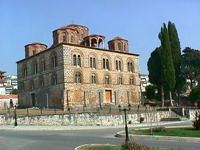
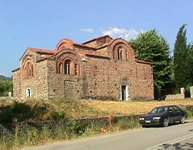
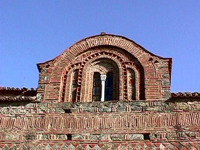
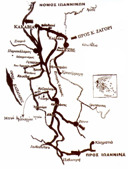
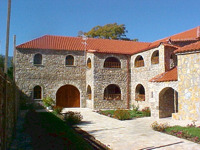
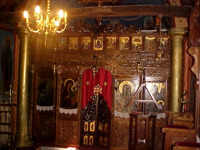
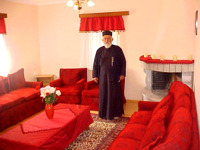
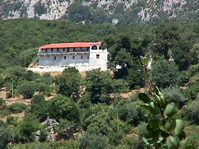
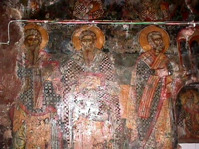
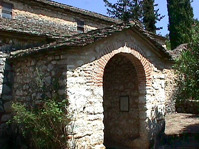
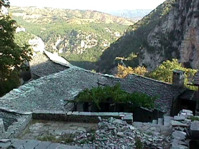
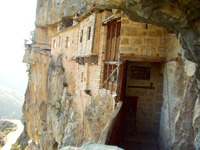
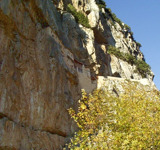
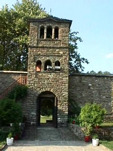
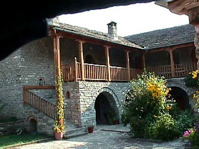
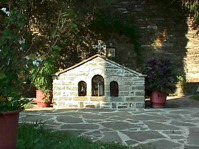 The grave of the Metropolitan Sevastianos
The grave of the Metropolitan Sevastianos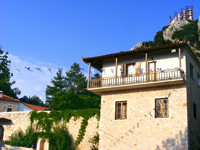
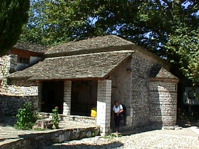
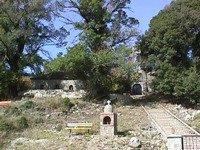
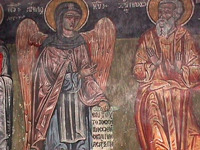
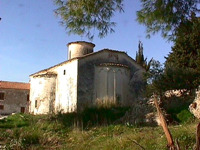
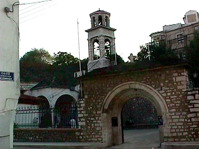
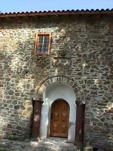
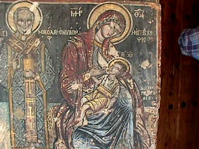
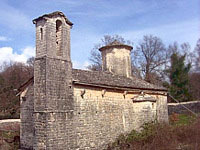
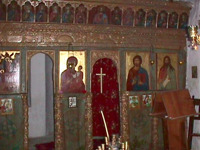
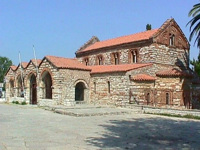
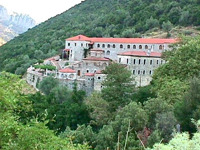
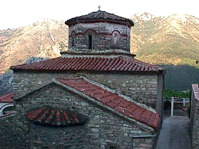
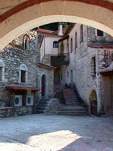
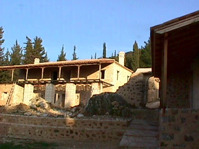
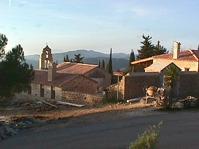
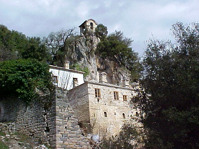
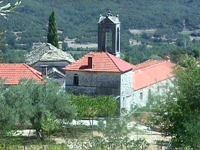
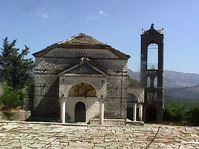
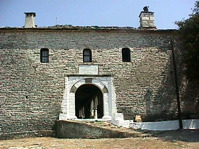
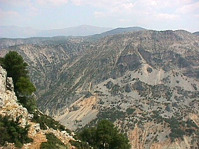
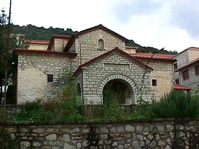
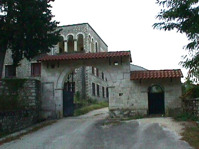
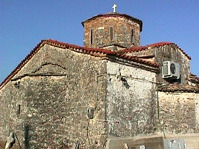
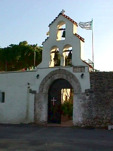
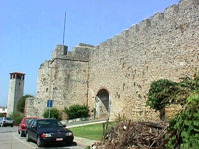
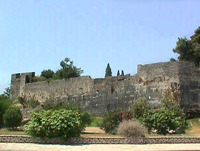
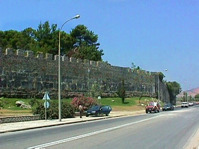
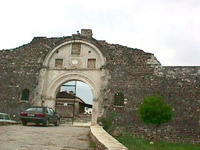
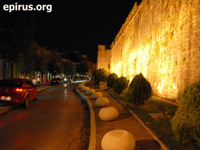
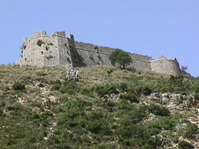
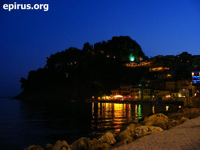
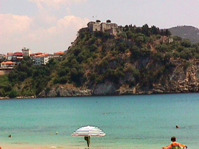
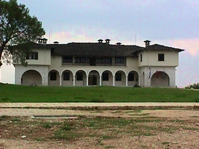
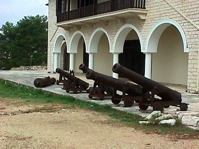
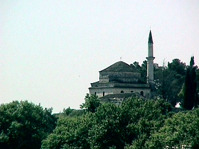
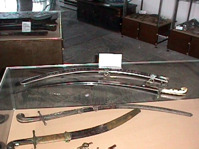
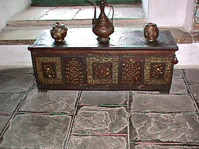
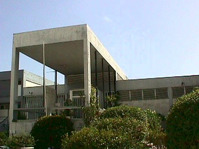
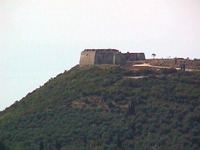
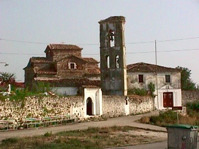
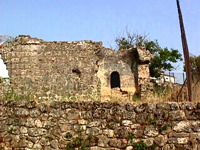
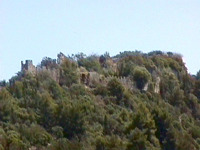
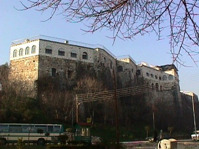
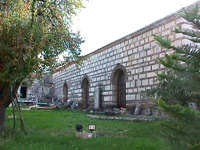
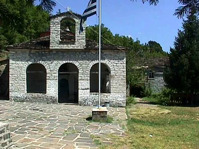
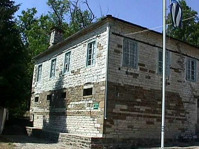
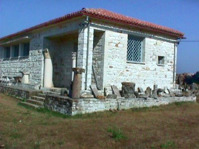
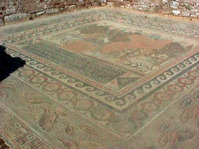
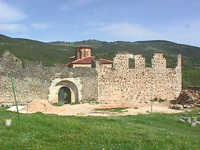
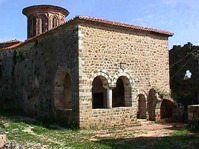
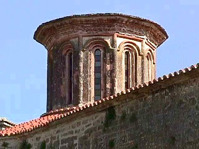
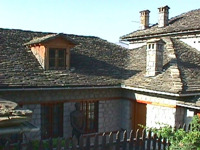
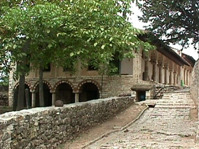
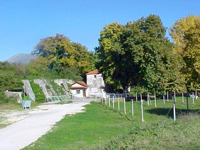
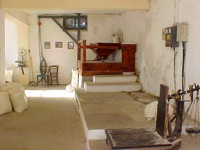
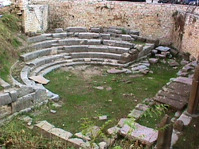

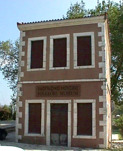
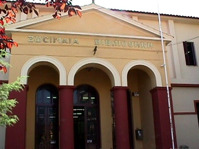
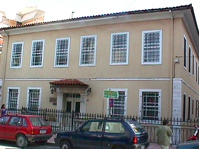
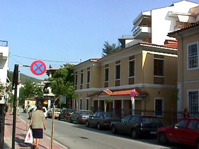
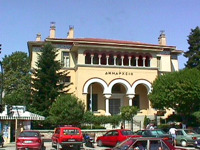
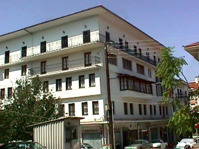
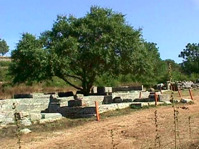
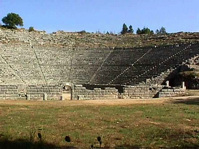
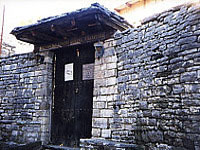
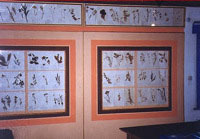
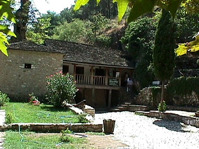
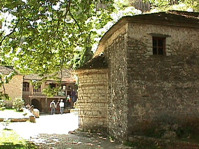
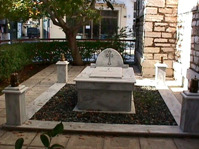
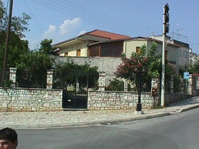
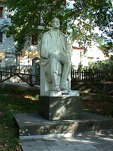
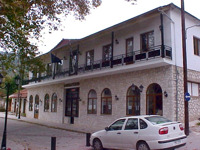
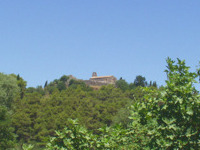
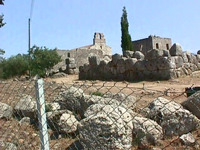
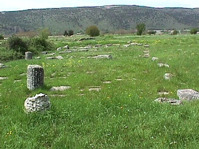
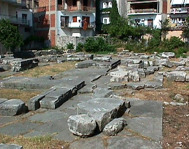
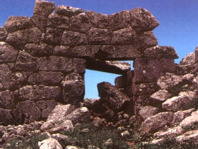
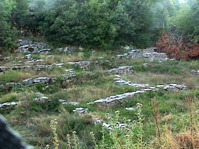
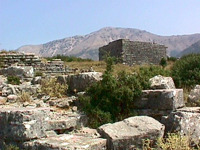
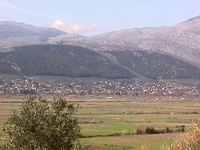
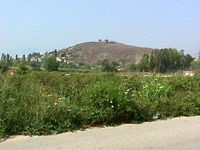
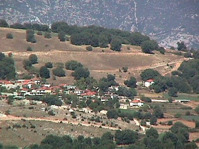
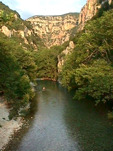
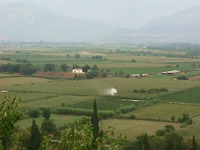
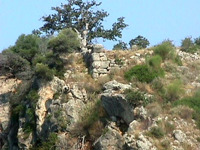
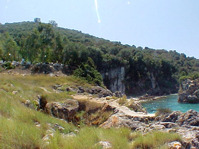
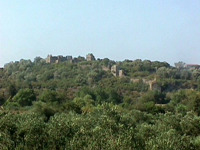
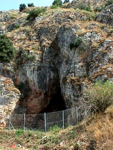
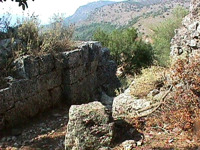
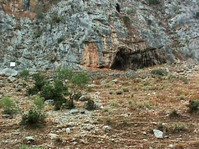
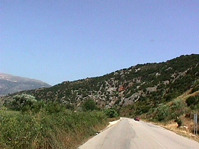
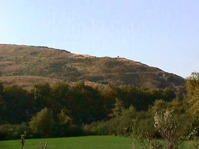
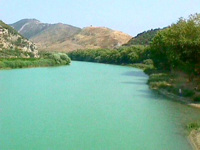
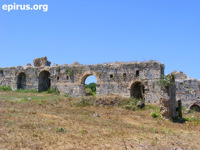
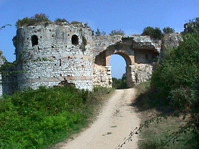
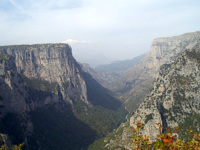
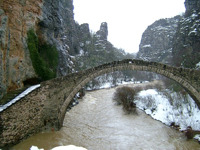
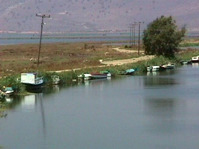
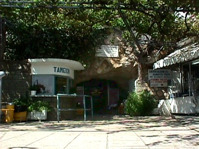
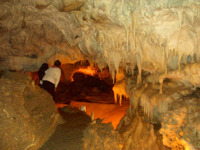
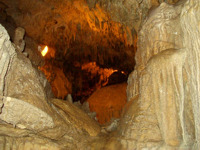
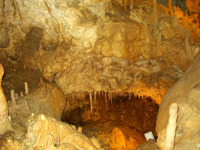
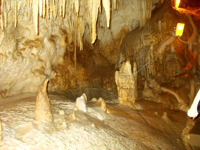
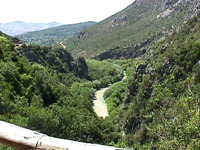
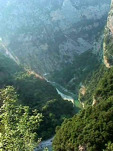
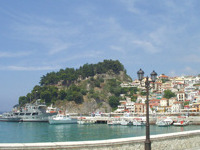
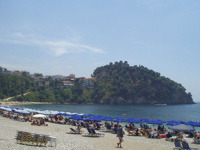
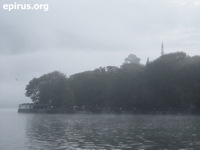
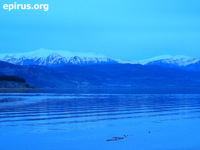 From Pamvotida Lake
From Pamvotida Lake